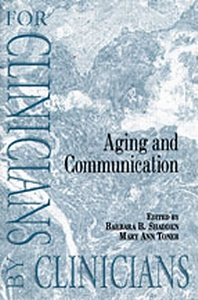Aging and Communication

For Clinicians, By Clinicians Series
This volume in the For Clinicians by Clinicians series, edited by Deannie Vogel and Mike Cannito, introduces management issues and model clinical practices for older adults based on a foundation of information and theory about normal aging. In that aging itself is not a disorder, this text represents a departure from the usual publications in this series. The text should be useful to students in courses emphasizing life-span aspects of communication behavior, disorders, and interventions. It is also intended to provide practitioners with information designed to enhance service delivery to older adults in a variety of settings.
The text is divided into two main sections. In the first section, titled “Aspects of Aging: A Continuum of Functioning”, contributors discuss aspects of normal aging and define characteristics of older adults that may influence responses to communication disorders, performance in assessment and treatment sessions, and communicative effectiveness in real-life situations. Throughout this section, emphasis is on the heterogeneity of the aging experience. Written by practitioners from a variety of disciplines, the chapters address topics ranging from the broad social, physical, and cognitive/emotional aspects of aging to more focused reviews of age-related problems in hearing, speech, voice, swallowing, language, and communication.
Topics in the second section, titled “Intervention Approaches: A Continuum of Care Settings and Service Delivery Models,” include functional assessment, innovative models for intervention with specific clinical populations (e.g., persons with dementia, hearing impairment, swallowing disorders), caregiver programming, and approaches to meeting the broader communication needs of older adults. This section also provides an overview of factors that influence successful provision of services, including care settings, funding issues, and community resources.


